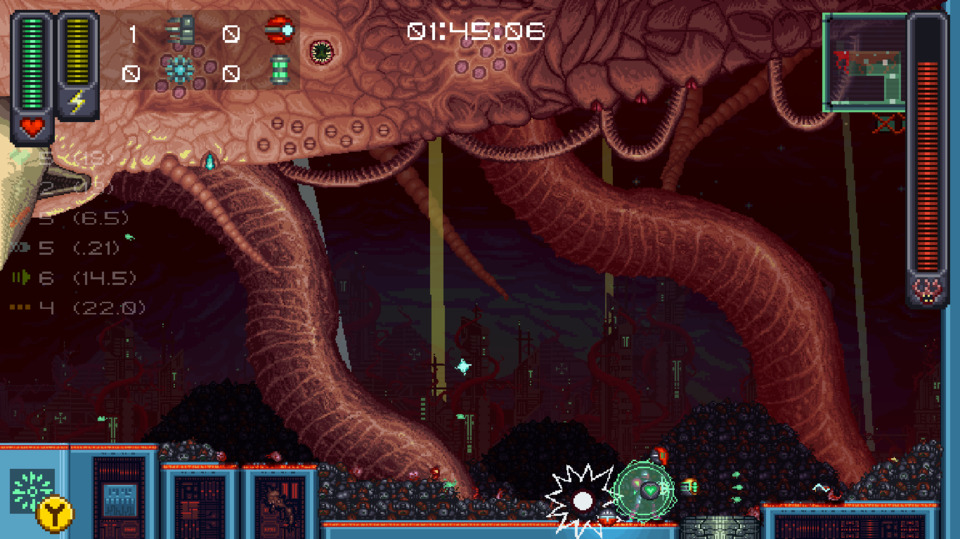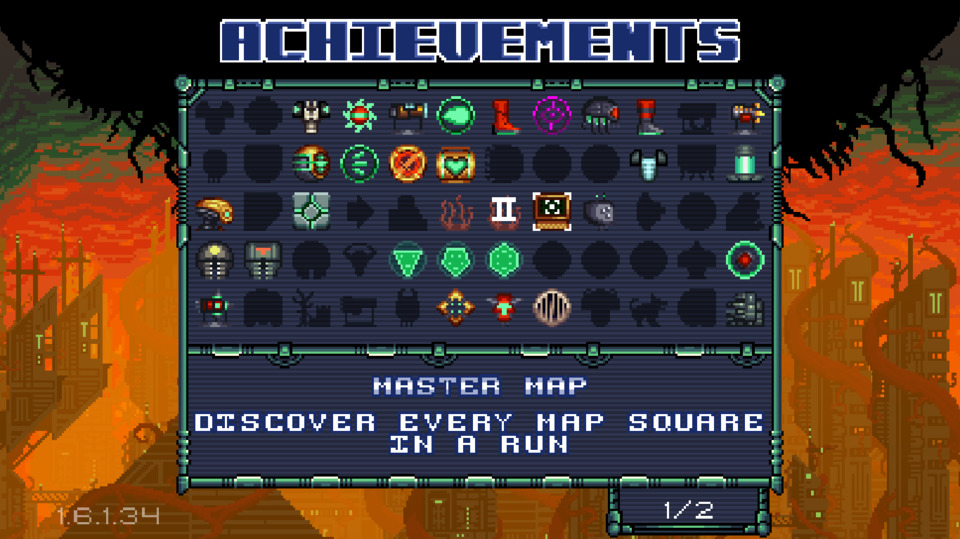Indie Game of the Week 254: A Robot Named Fight!
By Mento 0 Comments

I happened to catch a developer interview talking about this week's game, the run-based explormer A Robot Named Fight! and another 2017 game that didn't quite make last year's Dredge of Seventeen feature, and the developer highlighted Super Metroid and The Binding of Isaac as particular influences. That saves me from having to get too deep into how this game is the exact median point between the two, though I'm going to do so anyway. In A Robot Named Fight!, a certain amount of time has passed on Earth and highly adaptable robotic life has spread across the globe and taken their first steps towards the stars. A sudden appearance of a malignant, moon-sized ball of flesh called "The Megabeast" disrupts the peace of this inorganic utopia, spreading its mutant children across the planet's surface and beneath. As a pacifistic society that (mostly) did away with its organic oppressors millennia ago, the robot civilization is ill-equipped to deal with this threat: all save one, the robot named Fight, who decides to explore the subterranean world for any ancient weapons left behind by his ancient forebears and use them to take on this extra-terrestrial interloper.
I've played a few run-based explormers before (Eagle Island and Sundered are two such examples, and Dead Cells is probably the most famous case), but A Robot Named Fight! is the closest to the image I have in my mind when combining the two genres. It looks, plays, and feels like a Super Metroid ROM hack that not only randomizes the locations of the important progress-enabling traversal upgrades but also the world geography and the intended critical route, and has enough surplus content that you're never guaranteed to see the same bosses, areas, weapons, accessories, stat upgrades, and traversal tools in any two runs. That's where The Binding of Isaac comparison is keenest felt: A Robot Named Fight! is built on its replay value, and completing certain objectives like reaching an area for the first time, defeating a specific boss for the first time, fully exploring the map, or killing a milestone total of enemies across all runs will unlock content that may appear in future runs. Not just upgrades, in fact, but new areas, new bosses, and new modes like the Boss Rush. True to its nature as a run-based game there is no hard saving your progress while in a playthrough: you die, you're done. However, you can save and quit if you need to do something else in a hurry, and it should be noted that a single session won't take you too long: a typical successful run takes about an hour, or closer to 90 minutes if you're running back and forth to acquire every upgrade going.

The Super Metroid comparison isn't just skin-deep, like it can be in other Indie explormers that often riff on the style rather the mechanics: care has been taken to make sure A Robot Named Fight! plays almost identically, with controls for aiming up and down (set to separate triggers, conveniently) where you need to be careful to position yourself in a way that your stream of bullets will destroy incoming enemies before they get too close, and it even has that same kind of weight to its armored protagonist that has them hitting solid ground with some impact whenever they jump from high up. Most of the upgrades are the same way, including alternative weapon modes that you can switch between that open specific color-coded doors and those that are always active and increase firepower and/or spread, a means of slipping under gaps (there's actually a few of these, though they all function more or less the same), double-jumps and triple-jumps and jetpacks for continuous upward motion, and many, many upgrades that simply add to one of your main stats: max health, max energy (to power special weapons), damage, rate of fire, movement speed, and projectile speed. (How many gun-based games bother to have upgrades for both rate of fire and projectile speed?)
Despite the visceral body horrors everywhere you turn - the alien mutant meat creatures are repulsive piles of flesh and eyes and teeth, and remind me a lot of the foes from Sega's Alien Syndrome - the game has this odd undercurrent of levity to it that occasionally reminded me of the games I used to play on the Atari ST and Sega Mega Drive made by self-effacing British developers who were often loath to take themselves too seriously. The developer is American for the record (I believe Kentucky-based?) but there's a certain sense of frivolity and knowing gross-out humor to some of its presentation that is subtle enough that I'm not wholly sure it was deliberate. One example is the game's foley work for its monsters and their slimy projectiles: they sound like left over sound effects from Boogerman, a cacophony of farts and squishes that undermines the perturbing Cronenbergian monster designs but in return gives the game a certain personality it might've otherwise been too dry without.

There's some other neat ideas too that are additive to the Super Metroid-lite experience that the game offers. One is a set of collectibles that can be traded to NPCs and the shrines to various cyber-deities with neat designs, the latter operating like the capricious altars in classic ASCII Roguelikes if you don't know the trick to getting the best results every time (it's not super difficult to work out, fortunately). Others include "champion" spawns of regular enemies that are tougher to kill and may move faster or hit harder but drop a temporary upgrade and more resources than usual. In addition to the usual suit, boot, and weapon upgrades you can also find orbs that follow you around and provide support, maps that can reveal whole areas or just the locations of bosses or upgrades, and there's a few cameo references from other games like the classic Castlevania high-arc throwing axe or a familiar-looking robot hound with a spring-powered back that the game simply names "Up Dog" (there is no Deez Nuts equivalent as far as I can tell, but then I haven't unlocked everything yet).
You do run into a little bit of repetition due to how the game generates its seeds and algorithms with a set number of room variations and, of course, dying means you have to start over every time - unless you've died once and unlocked the save tank feature, which resurrects you once per game - so a few early disastrous runs might sour the player on progressing any further, but once you get enough of those permanent unlocks and start seeing more variance and overpowering weapon/upgrade synergies - another The Binding of Isaac carry-over - the game becomes that much more compelling. Then you start being able to defeat the final boss with some regularity, which in turn makes the game harder again with new monster variations. I've surprised myself this month by liking two run-based games (the other being Loop Hero) even though I had sworn off them once upon a time, so they're evidently going to have to be more of a case-by-case basis from here on out.
Rating: 4 out of 5.
| < Back to 253: She and the Light Bearer | The First 100 | The Second 100 | > Forward to 255: Children of Zodiarcs |
